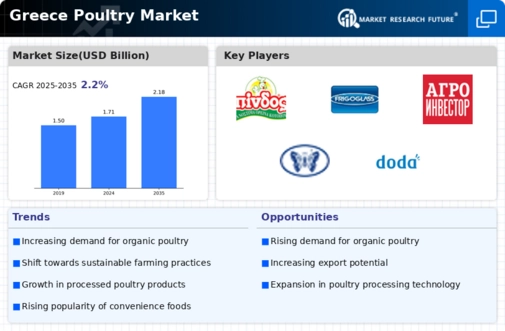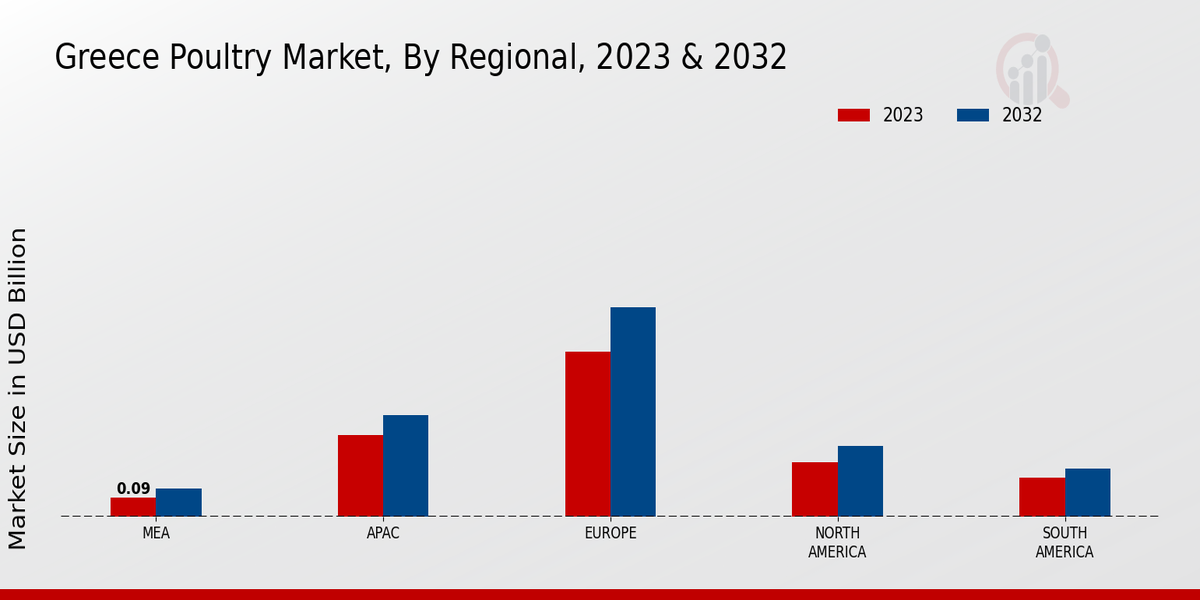Market Growth Projections
The Global Greece Poultry Market Industry is projected to experience substantial growth, with estimates indicating a market value of 1.71 USD Billion in 2024 and a rise to 2.18 USD Billion by 2035. This growth trajectory suggests a compound annual growth rate (CAGR) of 2.22% from 2025 to 2035. Factors contributing to this growth include increasing consumer demand for poultry products, advancements in farming technology, and expanding export opportunities. The market's resilience and adaptability to changing consumer preferences further underscore its potential for sustained growth in the coming years.
Rising Demand for Poultry Products
The Global Greece Poultry Market Industry is experiencing a notable increase in demand for poultry products, driven by changing consumer preferences towards protein-rich diets. As health consciousness rises, consumers are gravitating towards lean meats, particularly chicken, which is perceived as a healthier alternative to red meats. This trend is reflected in the projected market value of 1.71 USD Billion in 2024, indicating a robust consumer base that favors poultry. The increasing popularity of ready-to-cook and processed poultry products further supports this demand, suggesting a shift in consumption patterns that could sustain growth in the industry.
Advancements in Poultry Farming Technology
Technological advancements in poultry farming are significantly influencing the Global Greece Poultry Market Industry. Innovations such as automated feeding systems, climate control, and health monitoring technologies enhance production efficiency and animal welfare. These advancements not only improve yield but also reduce operational costs, making poultry farming more sustainable. As a result, the industry is likely to see an increase in production capacity, aligning with the projected growth to 2.18 USD Billion by 2035. The integration of technology in farming practices appears to be a key driver, potentially attracting investments and fostering competitive advantages.
Government Support and Regulatory Framework
Government support and a favorable regulatory framework are pivotal in shaping the Global Greece Poultry Market Industry. Policies aimed at promoting sustainable farming practices and ensuring food safety standards are instrumental in enhancing consumer confidence. Financial incentives for poultry farmers, such as subsidies and grants, encourage investment in modern farming techniques. This supportive environment is likely to stimulate growth, as evidenced by the anticipated market expansion to 2.18 USD Billion by 2035. The alignment of government initiatives with industry needs suggests a collaborative approach that could yield positive outcomes for poultry producers.
Export Opportunities in the Mediterranean Region
The Global Greece Poultry Market Industry is poised to benefit from expanding export opportunities within the Mediterranean region. Greece's strategic location and established trade agreements facilitate access to neighboring markets, enhancing the potential for poultry exports. Countries in the region are increasingly seeking high-quality poultry products, which positions Greece favorably. This trend is likely to contribute to the industry's growth, as exports could play a crucial role in achieving the projected CAGR of 2.22% from 2025 to 2035. The emphasis on quality and compliance with international standards further strengthens Greece's export potential.
Consumer Trends Towards Organic and Free-Range Poultry
The Global Greece Poultry Market Industry is witnessing a shift towards organic and free-range poultry products, driven by consumer preferences for ethically sourced food. As awareness of animal welfare and environmental sustainability grows, consumers are increasingly willing to pay a premium for organic poultry. This trend is reflected in the rising sales of organic poultry products, which are expected to contribute to the overall market growth. The industry's adaptation to these consumer trends may enhance its competitive edge, potentially leading to a more diversified product range that aligns with evolving market demands.

















Leave a Comment